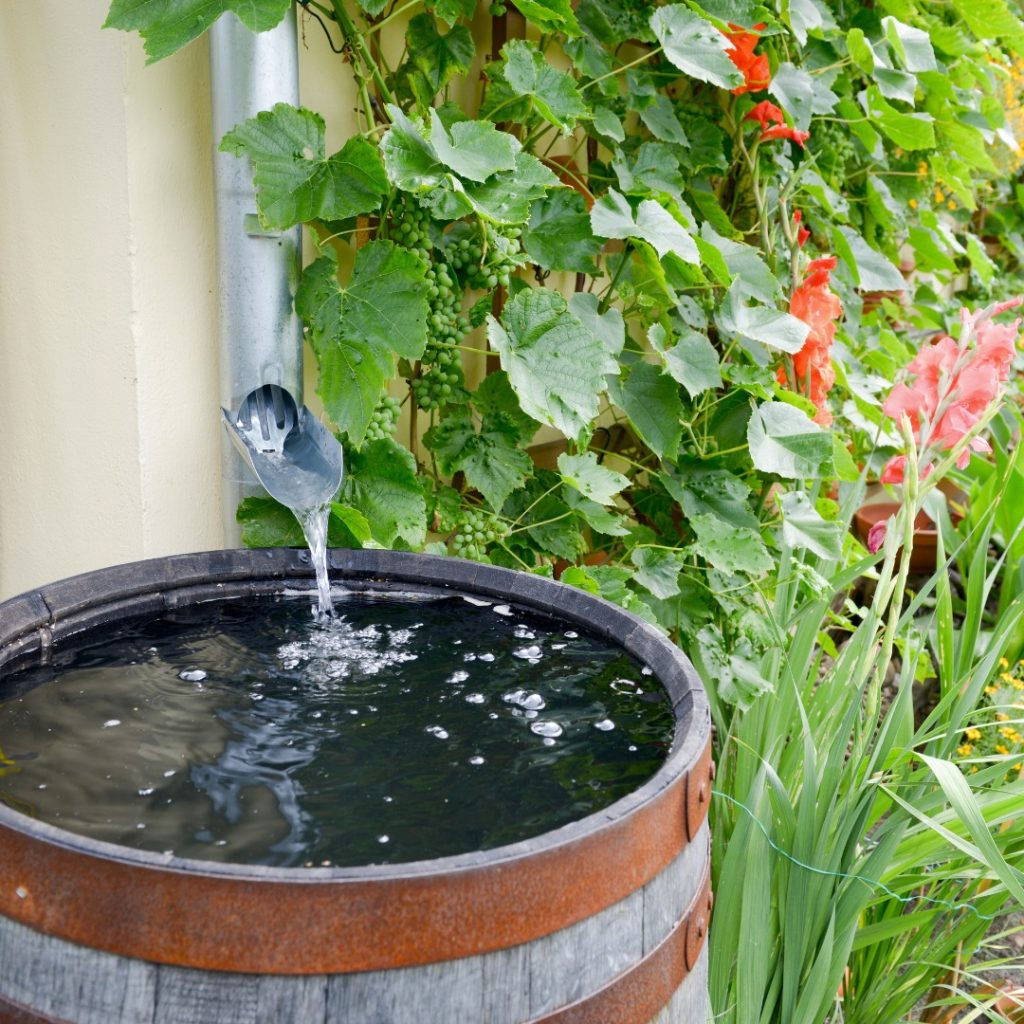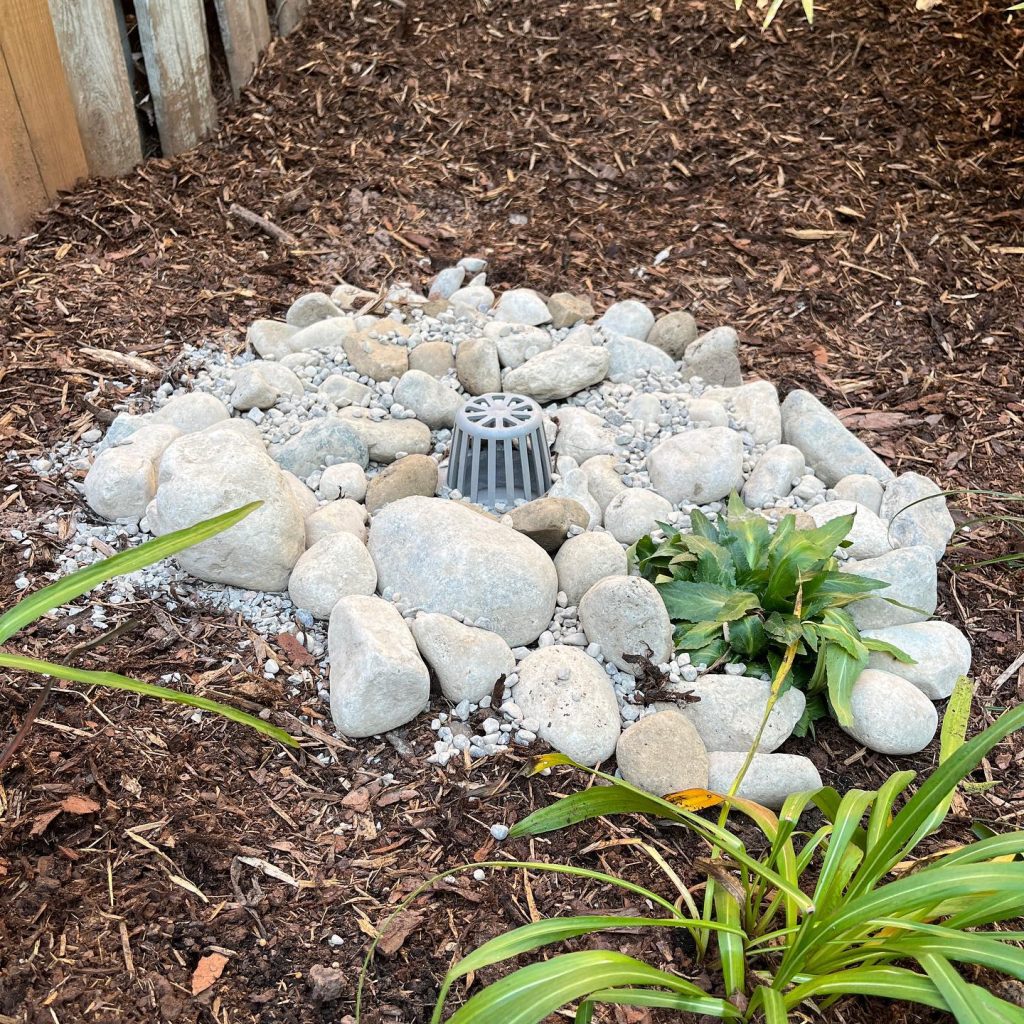Managing downspout runoff can seem like a daunting task, but with the right approach, it can be an opportunity to enhance your home’s landscaping and even save water. In this article, we’ll explore 18 creative and practical ideas that help you effectively manage downspout runoff. These ideas not only protect your home from potential water damage but also add beauty and functionality to your outdoor spaces. Whether you have a small yard or a sprawling garden, there’s a solution for every space.
1. Install a Rain Barrel for Water Conservation

One of the easiest and most eco-friendly ways to manage downspout runoff is by installing a rain barrel. A rain barrel collects water from your downspout and stores it for later use. This is a fantastic way to conserve water and reduce your reliance on municipal water systems. The stored water can be used for watering plants, cleaning outdoor furniture, or even for larger landscaping needs.
Rain barrels are available in various sizes, and some even come with a decorative design, making them an attractive addition to your garden or backyard. They’re easy to install, and the cost is relatively low compared to other water management solutions. Additionally, by using rainwater, you’re not only saving money on your water bill, but you’re also helping to reduce the strain on local water supplies.
To get the most out of your rain barrel, be sure to place it on a level surface, and connect it properly to your downspout. You can also add a filtration system to keep debris out of the stored water. For added convenience, install a spigot near the bottom of the barrel to make it easy to access the water.
2. Create a Rain Garden

Rain gardens are a beautiful and functional solution for managing downspout runoff. These gardens are designed to capture rainwater and allow it to naturally absorb into the ground, preventing water from pooling around your home. A rain garden can be filled with native plants that are both drought-tolerant and beneficial to local wildlife.
When planning a rain garden, it’s important to select plants that can thrive in the moist conditions created by runoff. Plants like ferns, sedges, and flowering perennials work well in these environments. Additionally, creating a rain garden gives you the opportunity to add more variety and beauty to your outdoor space while managing water efficiently.
Rain gardens also help to filter out pollutants from runoff before it enters stormwater systems, making them an environmentally friendly choice. If you’re concerned about the aesthetics of the garden, you can design it to complement your overall backyard landscaping by incorporating decorative stones or low-maintenance mulch.
3. Use a French Drain to Divert Water

A French drain is an effective way to direct downspout runoff away from your foundation and other problem areas. This drainage system consists of a perforated pipe surrounded by gravel, which allows water to flow freely through it and away from your home. The French drain is buried in the ground and can be designed to follow the natural slope of your yard, ensuring that water flows away from critical areas.
While French drains are commonly used to prevent flooding, they’re also ideal for managing downspout runoff. They can be installed in areas where surface water tends to pool, such as near patios or along the side of your house. With proper installation, a French drain can handle large amounts of water, preventing erosion and foundation damage.
To install a French drain, you’ll need to dig a trench, place the perforated pipe, and cover it with gravel. Depending on the size of your yard and the volume of runoff, it might be worth hiring a professional to ensure that the system is installed correctly.
4. Install a Splash Block

Splash blocks are a simple yet effective way to direct downspout runoff away from your foundation and landscaping. These blocks are placed at the base of your downspout and help to channel water further from the foundation, preventing erosion and water damage. Splash blocks are often made of concrete, plastic, or stone, and they come in various sizes and designs.
A splash block works by dispersing the water in multiple directions, allowing it to flow gently across your yard. This helps to prevent the water from pooling in one area, which can lead to damage. Splash blocks are especially useful in areas where water runoff is minimal, but you still want to protect the surrounding landscaping from excess moisture.
To maximize the effectiveness of a splash block, make sure it’s placed on a slight incline to encourage water to flow away from your home. You can also enhance the aesthetic by selecting a decorative block that complements your outdoor decor.
5. Build a Dry Creek Bed
Source
A dry creek bed is an excellent way to handle downspout runoff while adding visual appeal to your landscape. It’s essentially a trench lined with rocks or gravel that mimics the natural flow of a stream. The dry creek bed guides water from the downspout to a designated area, where it can slowly soak into the ground or be redirected to another drainage system.
Dry creek beds can be customized to fit any backyard style. You can create a winding, natural path that blends seamlessly with your landscaping, or you can opt for a more structured design. Either way, a dry creek bed is both functional and beautiful. It also helps prevent erosion by slowing down the flow of water and allowing it to seep into the soil.
When planning a dry creek bed, consider the amount of water your downspout typically handles and the slope of your yard. This will help you determine the size and depth of the bed, ensuring it can handle the runoff effectively.
6. Create a Gravel Trench
Source
A gravel trench is another effective method for managing downspout runoff, especially in areas where a more natural solution is desired. The trench is filled with gravel, which allows water to flow through it and be absorbed by the surrounding soil. Gravel trenches are particularly useful in regions with heavy rainfall or areas prone to water pooling.
Gravel trenches work by slowing down the water, giving it time to filter into the ground. They’re also relatively low-maintenance compared to other drainage solutions. Over time, the gravel helps to break down and filter out contaminants from the runoff, keeping your yard cleaner and safer for plants and animals.
To install a gravel trench, you’ll need to dig a shallow trench along the path of your downspout and fill it with gravel. You can line the trench with landscaping fabric to prevent the gravel from mixing with the soil, ensuring long-term effectiveness.
7. Use Downspout Extension Hoses
Source
Downspout extension hoses are an affordable and convenient option for redirecting downspout runoff away from your home. These flexible hoses can be attached to the end of your downspout and directed to an area further from your foundation, such as a garden or lawn. They come in a variety of lengths and materials, making them versatile for different types of properties.
One of the key benefits of downspout extension hoses is their flexibility. They can be easily moved, which makes them a great temporary solution or a way to test different runoff management options. Additionally, many hoses are designed to handle large amounts of water, making them effective for dealing with heavy rainfall.
When using a downspout extension hose, make sure to position the hose in a way that water flows away from your home and doesn’t pool in low-lying areas. You can also bury the hose under mulch or grass for a more aesthetically pleasing look.
8. Install a Rain Chain
Source
Rain chains are a stylish and functional alternative to traditional downspouts. They allow water to flow down in a visually appealing way while still managing runoff effectively. Made of metal links, cups, or bowls, rain chains are designed to catch the water as it flows from the roof and direct it gently to the ground or a collection system.
Aside from their practical function, rain chains add a decorative touch to your home’s exterior. They can be customized in various materials such as copper, aluminum, or stainless steel, each offering a unique look that complements your outdoor decor. The gentle sound of the water cascading down the chain can also add a calming element to your yard or garden.
To make the most of a rain chain, install it in a way that directs water away from your home’s foundation. You can also place a decorative basin or catchment system at the bottom of the chain to collect the water for future use.
9. Integrate a Paver Drainage System
Source
Paver drainage systems are an innovative solution for managing runoff in areas where hardscaping is present, such as patios or driveways. These systems allow water to flow through the pavers and into the ground, reducing the amount of water that runs off into your yard. This method is particularly useful in areas with heavy rainfall or for homeowners who want to avoid pooling water on their patios or walkways.
There are several types of paver drainage systems, but the most common involves installing permeable pavers that allow water to pass through. These pavers are designed with small gaps or holes, enabling water to drain into the ground rather than running off into the surrounding area.
By integrating a paver drainage system into your outdoor design, you can ensure that your hardscaped areas remain dry and free from standing water, while also improving the overall drainage of your property.
10. Build a Permeable Paver Pathway
Source
If you’re looking for a practical yet visually appealing way to manage downspout runoff, consider building a permeable paver pathway. These pathways are designed with materials that allow water to pass through, preventing runoff from accumulating in one area. Instead of running off into your yard, the water will slowly filter through the gaps in the pavers and be absorbed into the soil beneath.
Permeable pavers come in a variety of styles, from traditional brick to modern concrete, giving you the flexibility to design a pathway that complements your outdoor space. You can place this pathway near your downspout, guiding water to an area where it can be absorbed by plants or redirected to a rain garden or dry creek bed.
The beauty of permeable paver pathways is that they don’t require much maintenance, and they can help prevent puddles and standing water on your property. They’re also environmentally friendly, as they allow rainwater to be naturally filtered into the ground, reducing runoff into storm drains.
11. Create a Catch Basin with a Filter
Source
A catch basin with a filter is a highly effective way to manage downspout runoff, especially in areas that experience a significant amount of rainfall. The catch basin is designed to capture excess water and direct it into an underground pipe or drainage system. By adding a filter to the catch basin, you can prevent debris from clogging the system, ensuring that water flows smoothly.
Catch basins are often used in areas with heavy runoff, such as driveways or patios, but they can be installed in almost any part of your yard. The filter helps to capture not only debris but also pollutants, preventing them from entering your stormwater system or harming local ecosystems.
Installing a catch basin with a filter requires a bit more effort than simpler solutions, but the payoff is worth it. This system will efficiently manage large amounts of water and protect your home from water damage, all while being relatively low-maintenance.
12. Redirect Water to a Garden Bed
Source
If you have a garden bed that could use a little extra moisture, why not redirect your downspout runoff to it? This is a simple, cost-effective solution that makes use of the water that would otherwise pool near your home. By adjusting the downspout to direct water toward your garden bed, you can nourish your plants without using municipal water.
When planning this solution, ensure that your garden bed is located downhill from the downspout to allow the water to flow naturally. You can also add mulch to the garden bed to help retain the water and reduce evaporation, giving your plants the moisture they need to thrive. This is an ideal option for flower beds or vegetable gardens, as the water can be used to support plant growth.
Redirecting runoff to garden beds helps prevent erosion and reduces water waste, making it a win-win solution for your landscaping. You’ll not only conserve water but also reduce the risk of flooding or damage to your home’s foundation.
13. Use a Subsurface Drainage System
Source
For more advanced water management, consider installing a subsurface drainage system. This system involves placing perforated pipes below the ground that collect water from downspouts and direct it to an area away from your home. The water then filters through the soil, reducing the amount of runoff that reaches your yard’s surface.
Subsurface drainage systems are particularly useful in areas that experience heavy rainfall or have poor soil drainage. They are effective at preventing water from pooling around your home’s foundation and can be designed to integrate seamlessly into your yard’s landscape. For example, you can hide the pipes beneath garden beds or under decorative features like rocks or pavers.
Installing a subsurface drainage system is a more involved project, but it’s an excellent long-term solution for managing significant runoff. It’s also a great way to improve the overall drainage of your property while maintaining the aesthetic appeal of your outdoor space.
14. Use a Downspout Extender with a Drainage Basin
Source
A downspout extender with a drainage basin is a straightforward solution for managing runoff from your downspout. The extender is a flexible tube that attaches to the end of your downspout and directs the water further away from your home. The drainage basin collects the water, allowing it to flow into a designated area, such as a garden or lawn.
This system is easy to install and requires minimal maintenance, making it a popular choice for homeowners who want to keep water away from their foundation. Downspout extenders are available in various lengths and materials, and some even feature built-in filters to prevent debris from clogging the system.
You can enhance the functionality of a downspout extender by adding decorative elements to the drainage basin, turning a simple solution into a visually appealing feature of your yard.
15. Create a Water Feature or Pond
Source
Why not turn downspout runoff into a beautiful water feature or pond? By directing the runoff to a pond, you can create a tranquil outdoor space where the water can naturally filter and recirculate. Water features, such as fountains or small ponds, add a touch of serenity to your landscape while managing runoff.
When planning a pond or water feature, it’s important to ensure that it’s deep enough to handle the amount of water your downspout delivers. You can incorporate decorative rocks, aquatic plants, or fish to make the feature more attractive and functional. This solution also helps reduce water waste, as the runoff can be collected and reused to maintain the pond.
If you want to take it a step further, consider adding a filtration system to keep the water clean and clear. This is a great way to create a sustainable water management system that doubles as an eye-catching outdoor feature.
16. Use a Grassy Swale to Guide Water
Source
A grassy swale is a natural and low-maintenance solution for redirecting downspout runoff. This shallow trench, lined with grass and other plants, helps guide water from your downspout to a designated area where it can be absorbed into the soil. Swales are ideal for properties with a gentle slope, as they encourage water to flow away from your home while providing a habitat for local flora and fauna.
Grassy swales work by slowing down the flow of water, allowing it to soak into the ground rather than running off. They can be designed to blend in with the natural landscape, and the plants in the swale can help filter out pollutants from the runoff.
This solution is particularly useful for homes located in areas where surface water is a concern, such as in flood-prone regions or areas with heavy rainfall. A well-designed swale will reduce the risk of erosion and foundation damage while maintaining the beauty of your yard.
17. Install a Water Harvesting System
Source
Water harvesting systems are a fantastic way to make the most of your downspout runoff. These systems collect water from your downspout and store it for future use, whether for irrigation, cleaning, or even household use in some cases. By installing a rainwater harvesting system, you can significantly reduce your reliance on municipal water, saving both money and resources.
There are several types of water harvesting systems, from simple rain barrels to more complex systems that filter and store large quantities of water. You can install a system that fits your needs, whether you’re looking for a small solution for your garden or a more extensive setup for landscaping or agricultural use.
Water harvesting systems are easy to install and can be customized to match the aesthetics of your home. With the right setup, you can ensure that your downspout runoff is put to good use, helping the environment while saving you money.
18. Convert Runoff into a Sustainable Landscaping Feature
Source
Finally, consider converting your downspout runoff into a sustainable landscaping feature. By utilizing rainwater for irrigation, you can create a low-maintenance garden that requires little to no additional water. Additionally, using runoff to nourish native plants or low-water-use shrubs reduces the need for traditional irrigation systems, lowering your water bill and helping the environment.
A sustainable landscaping feature can include native plants, rain gardens, permeable pathways, or any other water-efficient solutions that help you make the most of your runoff. These features can be integrated into your overall landscape design, ensuring that your yard is both beautiful and environmentally friendly.
Converting runoff into a sustainable landscaping feature allows you to take full advantage of natural resources, transforming your yard into a more eco-friendly space while reducing water waste.
Conclusion
Managing downspout runoff doesn’t have to be a difficult or tedious task. With the 18 creative and practical ideas outlined in this article, you can protect your home from potential water damage, conserve water, and enhance the aesthetic appeal of your outdoor space. From rain gardens to rain barrels, dry creek beds to permeable pavers, there’s a solution that fits every need and style.
By taking proactive steps to manage runoff effectively, you’ll be creating a more sustainable and attractive environment for both you and your community. Happy gardening and outdoor living!

